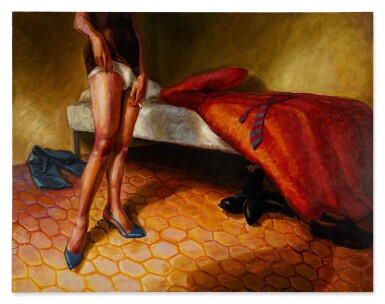Contemporary Discoveries
Contemporary Discoveries

Hugh Steers
Cobalt Heels
Lot Closed
March 16, 04:04 PM GMT
Estimate
25,000 - 35,000 USD
Lot Details
Description
Hugh Steers
1962 - 1995
Cobalt Heels
signed Hugh Steers, titled and dated '91 (on the reverse)
oil on canvas
56 by 72 in.
142.2 by 182.9 cm.
Executed in 1991.
Richard Anderson Gallery, New York
Collection of Wheelock Whitney III (acquired from the above)
Barbara Schröder & Karen Kelly, eds., Hugh Steers: The Complete Paintings, 1983-1994. New York: Visual AIDS, 2015, no. 367, illustrated p. 38, p. 219
“I think I’m in the tradition of a certain kind of American artist – artists whose work embodies a certain gorgeous bleakness. Edward Hopper, Jackson Pollock, Franz Kline – they all had this austere beauty to them. They found beauty in the most brutal forms. I think that’s what characterizes America, the atmosphere, its culture, its cities and landscapes. They all have that soft glow of brutality.” – Hugh Steers, September 1992
Steers’ understanding of color and light, and his ability to express a wide range of emotions through figuration, reveal his deep knowledge of and direct influences from art history. The contrasting light of his work often references Michelangelo Merisi da Caravaggio, his elongated and sharp figures are informed by El Greco, his intimate imagery and unorthodox poses point to Pierre Bonnard and Edgar Degas, and his figurative compositions speak to Edward Hopper. Grounded in technique and the history of Western painting, he described his work as “allegorical realism” rendered "to draw the viewer in through the lure of a comfortingly recognizable style and then confront him with a subject matter of a challenging nature."
Diagnosed in 1987 with HIV, Steers’ subject matter often speaks to the experience of living through an evolving Queer identity and the devastating AIDS crisis. Much of his work addressed illness, isolation, alienation, companionship, and sexuality. While he described his images as “metaphors that come from very specific needs and things on my part,” he repeatedly insisted that the meanings of his paintings depended on what the viewer brings to them. (Hugh Steers: Daylight, Exh. Cat., Alexander Gray Associates, New York, 2015, pp. 3-4.)
